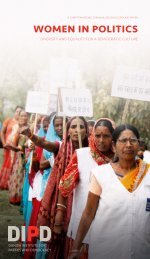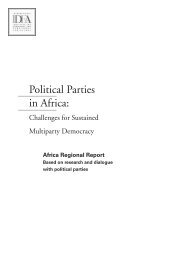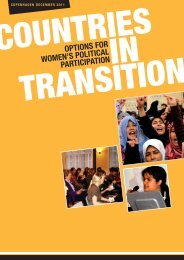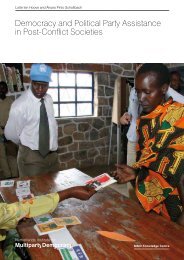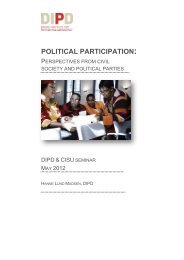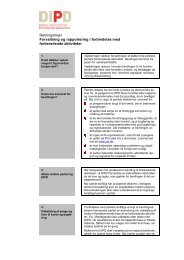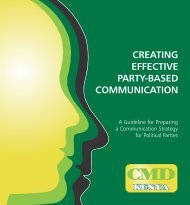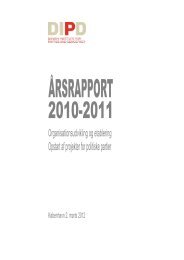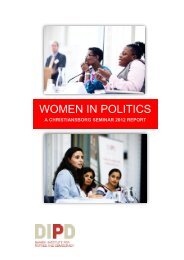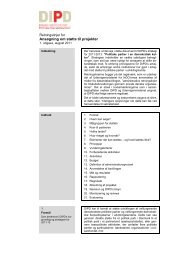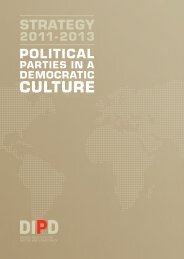FOLKETINGET – THE DANISH PARLIAMENT
FOLKETINGET – THE DANISH PARLIAMENT
FOLKETINGET – THE DANISH PARLIAMENT
Create successful ePaper yourself
Turn your PDF publications into a flip-book with our unique Google optimized e-Paper software.
<strong>FOLKETINGET</strong><br />
<strong>–</strong> <strong>THE</strong> <strong>DANISH</strong> <strong>PARLIAMENT</strong><br />
danish democracy,<br />
christiansborg palace
Folketinget<br />
-The Danish Parliament<br />
September 2010<br />
Published by<br />
Communications<br />
Christiansborg Palace<br />
1240 Copenhagen K<br />
Photographs<br />
Anders Hviid, Bjarke Ørsted/Scanpix,<br />
Christoffer Regild, Henrik Sørensen,<br />
Janne Klerk, Thorkild Jensen<br />
Impression<br />
1.000 copies<br />
Print<br />
Grafisk Rådgivning
CONTENTS<br />
DanIsh Democracy Page 6<br />
Universal suffrage is the foundation of democracy. This<br />
principle was laid down in the Constitutional Act of June<br />
1849, the main principles of which are still to be found in<br />
the present Constitutional Act of the Kingdom of Denmark,<br />
which dates from June 5th 1953.<br />
The cenTre oF The realm For 800 years Page 13<br />
Christiansborg Palace is very spacious. It was erected in<br />
the 18th century in order to set the frame for the Court of<br />
the Danish absolute monarchs.<br />
commITTees <strong>–</strong> workshoPs oF The ParlIamenT Page 18<br />
The major debates take place in the Chamber and the formal<br />
decisions are made here. But the decisions are prepared in<br />
the committees of the Danish Parliament.<br />
From IDea To law Page 25<br />
Section 41 in the Constitutional Act of the Kingdom of Denmark<br />
lays down that a Bill shall be read three times in the<br />
Folketing before it can be adopted.
6<br />
The Constitutional Act comprises a<br />
number of civic rights. The Constitutional<br />
Act has been amended in<br />
1866, in 1915 and in 1953. It was<br />
only in 1915 that women and servants<br />
got the vote.<br />
DanIsh Democracy<br />
<strong>DANISH</strong> DEMOCRACY<br />
Danish democracy is founded on thoughts the<br />
seeds of which were sown in Europe during the<br />
18th century as a reaction against royal absolutism<br />
which infringed the freedom of the citizens.<br />
The power in society should not be imposed upon<br />
the people from above. All men are born free and<br />
equal and are therefore entitled to take part in<br />
elections in the legislative assemblies at various<br />
levels: the Parliament, the regional councils and<br />
the town councils.<br />
Universal suffrage is the foundation of democracy.<br />
This principle was laid down in the Constitutional<br />
Act of June 1849, the main principles of which are<br />
still to be found in the present Constitutional Act<br />
of the Kingdom of Denmark, which dates from<br />
June 5th 1953.<br />
Democracy is safeguarded not only by the<br />
Constitutional Act but also by the Parliamentary<br />
Election Act of Denmark. The electoral system<br />
based upon proportional representation guarantees<br />
that representatives of all parts of the<br />
country and exponents of any point of view <strong>–</strong><br />
organized in large minority groups or grassroot<br />
movements <strong>–</strong> obtain seats according to the<br />
number of votes cast. The remuneration which the<br />
popularly elected receive makes it economically<br />
possible for anyone to run for election irrespective<br />
of income.
K ING FR EDER IK V II SIGNED <strong>THE</strong> F IR ST<br />
CONST IT U T IONA L ACT OF <strong>THE</strong> K INGDOM OF<br />
DENM A R K ON J U NE 5TH 1849. THIS IS <strong>THE</strong><br />
R EASON W H Y CONST IT U T ION DAY IS CELEBR ATED<br />
EV ERY Y EAR ON J U NE 5TH BY POLITICI A NS M A K ING<br />
SPEACHES IN MANY DIFFERENT PLACES IN <strong>THE</strong><br />
COUNTRY.
8<br />
In Denmark, Cabinet responsibility<br />
means that a Governement must<br />
step down or call for a general<br />
election if it is confronted with a<br />
vote of no confidence or finds itself<br />
in a minority in the Folketing.<br />
DanIsh Democracy<br />
rights and duties<br />
It is characteristic of Danish democracy that the<br />
administration of the State is based on a voluntary<br />
agreement between the constitutional monarchy<br />
and the citizens of the country. The citizens have<br />
no direct influence on the administration of the<br />
State but exert their influence indirectly by voting.<br />
Referenda open up the possibility of gaining a<br />
direct popular influence. At the same time, citizens<br />
acknowledge the principle that it is up to the<br />
majority to make decisions and that one is in duty<br />
bound to observe the laws, to pay taxes, to do<br />
one’s military service etc. In return for this, the<br />
Constitutional Act gives the citizens some<br />
important rights and liberties so that they may<br />
feel free to act as they think fit in relation to their<br />
elected representatives. If a majority of citizens<br />
decide to exert their influence by means of their<br />
right to vote, they may remove politicians whom<br />
they find unsuited to wield power. And in accordance<br />
with the last part of the Constitutional Act<br />
(Sections 71-85), all citizens are guaranteed their<br />
personal liberties and are protected against<br />
infringements e.g. by the universal freedom of<br />
speech, the freedom of assembly, the safeguarding<br />
of private property, equal employment<br />
opportunities and the right to benefit from social<br />
services.<br />
separation of powers<br />
In order to ensure a stable democracy and to<br />
prevent misuse of power, the supreme power in<br />
Denmark is, like in most other Western democracies,<br />
divided into three independent organs which<br />
control one another i.e. the legislative, the<br />
executive and the judicial powers. The Parliament<br />
is the sole organ empowered to legislate. However,<br />
the Acts only take effect after receiving the Royal<br />
Assent. In practice, the Monarch is beyond the<br />
tripartite system but Her Majesty The Queen <strong>–</strong> or<br />
His Majesty The King <strong>–</strong> formally exerts authority<br />
e.g. when appointing or dismissing Ministers.<br />
The legislative and the executive powers are<br />
balanced against each other in the sense that a<br />
majority among the 179 Members of the Parliament<br />
can overthrow a Cabinet or a Minister by<br />
introducing an order paper which contains a vote<br />
of no confidence. On the other hand, the Prime<br />
Minister can dissolve the Parliament, at any time,<br />
in the hope of obtaining a more stable majority.<br />
The Ministers’ responsibility is a central point in<br />
democracy. They have extensive competences but<br />
are still under the control of the parliament and its<br />
25 standing committees.<br />
In special cases, Ministers may be impeached.
hIsTory oF The ParlIamenTary sysTem oF Denmark
politics in the public interest<br />
One of the main characteristics of democracy is<br />
that it is open and transparent to the general<br />
public. The entire political system from top to<br />
bottom is controlled and criticized by voters via<br />
the press and the other media.<br />
Likewise, the principle of transparency has been<br />
carried through in the public administration in the<br />
sense that all citizens have the right of access to<br />
documents and can complain to the Ombudsman<br />
or to the courts of justice if they feel that they are<br />
being treated unfairly.<br />
Political parties and organizations have the last<br />
say when candidates wish to stand for Parliament,<br />
as they draw up the lists for who shall represent<br />
them in the general election. Electoral rules date<br />
back to a time when a major part of the population<br />
was organized in political parties. These rules are<br />
still valid even though the number of people who<br />
belong to political parties has decreased considerably<br />
in recent decades to less than four percent of<br />
the population. However eighty or ninety percent<br />
of Danes tend to vote in general elections.<br />
Danish democracy has been functioning well<br />
within the framework of the Constitutional Act for<br />
more than 150 years even though the population<br />
has increased considerably during that period and<br />
despite the fact that the political awareness of<br />
citizens has increased. The political battle is not<br />
only a battle of points of view but also of economic<br />
interests. In certain periods, this has given rise<br />
to violent fluctuations in political life and to a<br />
feeling of distance between the voters and the<br />
candidates elected. But obviously, democracy is<br />
firmly rooted in Denmark as compared to other<br />
democracies.<br />
11<br />
The Danish Parliament, The<br />
Folketing, is composed of 179 MPs.<br />
175 MPs are elected in Denmark<br />
proper, 2 in Greenland and 2 in the<br />
Faroe Islands. Parliament passes<br />
laws and exerts control over the<br />
Government.
A DEVASTAT ING F IR E PU T A N END TO <strong>THE</strong> F IR ST<br />
CHRISTIANSBORG PALACE IN 1794, ONLY 50 YEARS<br />
A F TER ITS COMPLETION. HOW EV ER , <strong>THE</strong> R IDING<br />
GROU ND A ND <strong>THE</strong> COU RT <strong>THE</strong>ATR E SU RV IV ED<br />
<strong>THE</strong> FLAMES AND ARE TO THIS DAY PART OF <strong>THE</strong><br />
PALACE.
The cenTre oF The realm For 800 years<br />
<strong>THE</strong> CENTRE OF <strong>THE</strong> REALM<br />
FOR 800 YEARS<br />
Christiansborg Palace with its high copper-roofed<br />
towers topped by three royal crowns can be seen<br />
at a long distance <strong>–</strong> the big complex of buildings<br />
towers above the houses of the City centre. The<br />
Palace occupies a prominent position in the City<br />
of Copenhagen. Being the framework of Danish<br />
democracy, the Palace is, indeed, the centre of the<br />
whole country.<br />
the grand palace<br />
Christiansborg Palace is very spacious. It was<br />
erected in the 18th century in order to set the<br />
frame for the Court of the Danish absolute<br />
monarchs. At the time, the Kingdom of Denmark<br />
covered a vast area. The absolute monarchs also<br />
ruled Norway and the rich Duchies of Slesvig and<br />
Holstein. In order to show off to foreign visitors<br />
and to accommodate a Court which has, during<br />
some periods, been composed of more than 1.000<br />
persons, Christian VI made the first Christiansborg<br />
Palace spacious. Indeed, it became so big that to<br />
this very day, it still houses the most important<br />
organs of democracy. In addition to the Folketing,<br />
the Palace accommodates: the Royal Reception<br />
Rooms, the Prime Minister’s Office and the<br />
Supreme Court.<br />
absalon’s castle and the castle of<br />
copenhagen<br />
Christiansborg Palace is situated on the island of<br />
Slotsholmen. At present, the island is surrounded<br />
by narrow canals but in the Middle Ages, it was<br />
situated at some distance from the mainland and<br />
from the small fishing hamlet of Havn. Absalon,<br />
bishop of Roskilde, took an interest in the spot<br />
seeing in it a link with the archiepiscopal see of<br />
Lund. Therefore, in the 1160s, he erected a castle<br />
at Slotsholmen. It took the form of a big tower<br />
surrounded by a wall which was to serve as<br />
protection against the Vikings. The Castle survived<br />
for a good two hundred years. But in 1370, the<br />
Danish King, Valdemar Atterdag, was defeated by<br />
the Hanseatic towns in Northern Germany. The<br />
tearing down of the Castle was part of the peace<br />
terms. In the centuries which followed, the Danish<br />
Kings built a Palace at Slotsholmen, where they<br />
now took up residence <strong>–</strong> Copenhagen became the<br />
capital of the Realm.<br />
The first Christiansborg, a beautiful<br />
rococo Palace, burned down in 1794.<br />
The bridge and the buildings surrounding<br />
the courtyard remain, and<br />
are still in use.<br />
13
14<br />
The cenTre oF The realm For 800 years<br />
the first christiansborg palace<br />
In 1660, Denmark became an absolute monarchy<br />
which meant that the Kings now found the Castle<br />
of Copenhagen too small for their powerful<br />
position. In 1736, it was torn down, and as<br />
mentioned Christian VI built the magnificent first<br />
Christiansborg Palace <strong>–</strong> a four-winged rococo<br />
Palace with a riding ground, a Court Theatre <strong>–</strong><br />
which still stands <strong>–</strong> and a Palace Church, which<br />
was erected in the same place as the present one.<br />
For almost 50 years, a grand Court life unfolded<br />
here. But in 1794, the main wing caught fire, and<br />
the Palace and Palace Church burnt down.<br />
the second christiansborg palace<br />
The Second Christiansborg Palace was erected<br />
between 1806 and 1828 in the classical style of<br />
the era. The severity and modesty of that style<br />
were suited to the poverty which marked the<br />
country after the Napoleonic Wars. It was this<br />
Palace which became the centre of events when<br />
the country passed from absolute monarchy to<br />
democracy. A mass procession gathered in front of<br />
the Palace in March 1848. The result was that<br />
Denmark got her first democratic Constitution.<br />
Later the King handed over some of his rooms to<br />
the Rigsdag (Parliament) which literally sat down<br />
to work in January 1850 in the same wing of<br />
Christiansborg Palace as the one which today<br />
houses the Chamber. The life of this Palace was<br />
limited to some 50 years. In October 1884, the<br />
second Christiansborg Palace was burnt down in<br />
the midst of the most serious crisis in Danish<br />
politics. It was not possible to reach an agreement<br />
about the reconstruction. Therefore, the Palace<br />
was in ruins for twenty years before the reconstruction<br />
could begin.
IN OCTOBER 1884, <strong>THE</strong> SECOND CHR IST I A NSBORG<br />
PA L ACE WAS BU R NT DOW N IN <strong>THE</strong> M IDST OF <strong>THE</strong><br />
MOST SER IOUS CR ISIS IN DA N ISH POLITICS. IT WAS<br />
NOT POSSIBLE TO R EACH A N AGR EEMENT A BOU T<br />
<strong>THE</strong> R ECONSTRUCTION. <strong>THE</strong>R EFOR E , <strong>THE</strong> PA L ACE<br />
WAS IN RUINS FOR TWENTY YEARS BEFORE <strong>THE</strong><br />
R ECONSTRUCTION COU LD BEGIN.
the third christiansborg palace<br />
The erection of the present <strong>–</strong> and third <strong>–</strong> Christiansborg<br />
Palace began in 1906 using the same<br />
walls that had been used for the two previous<br />
Palaces. The style was neobaroque. The heaviness<br />
and solidity of the building were meant to<br />
underline the importance of the Palace as political<br />
centre of the Realm. The façades were decorated<br />
with symbols signifying the importance of the<br />
Palace: The base facing the Grand Square was<br />
carved in stones of granite donated by the<br />
individual local authorities of the country. The<br />
decorations in sand stone above the windows<br />
show all the city and county arms of the country as<br />
well as the faces of famous Danish politicians.<br />
At present, the main part of the Palace is used by<br />
the Parliament. The focal point is the Chamber<br />
The cenTre oF The realm For 800 years<br />
with its impressive rostrum encompassing the<br />
Speaker’s and the spokesman’s table and the<br />
highly decorated stucco ceiling with all the national<br />
symbols. Behind the Chamber is the Lobby,<br />
which <strong>–</strong> like a main thoroughfare <strong>–</strong> runs right<br />
across the building, typical of its era with its<br />
simple art nouveau frieze, beautiful vaults and<br />
solid panels.<br />
In order to provide reasonable working conditions<br />
for the 179 Members of the Parliament, the rooms<br />
above the stables of one of the Riding Ground<br />
wings as well as Christian IV’s old warehouse,<br />
dating back to 1603, have been incorporated as<br />
office facilities.<br />
On session days, the various rooms of the<br />
Parliament house about 1.200 persons.<br />
17<br />
The present Palace of Christiansborg<br />
was inaugurated in May 1918.<br />
The major part of the Palace houses<br />
Parliament. The other wings are<br />
occupied by the Prime Minister’s<br />
Office, the Supreme Court and the<br />
Royal Reception Rooms.
18<br />
Subsequent to the first reading in<br />
the Chamber the committees deal<br />
with the Bills in question and<br />
elaborate a report. Such a report<br />
will often contain amendments<br />
made by the parties. There are 25<br />
standing committees consisting of<br />
17 Members each. The largest<br />
parties make out the majority of<br />
the committee Members.<br />
commITTees <strong>–</strong> workshoPs oF The ParlIamenT<br />
COM MIT TEES<br />
<strong>–</strong> WORKSHOPS OF <strong>THE</strong> <strong>PARLIAMENT</strong><br />
Major debates take place in the Chamber and<br />
formal decisions are made here. All plenary<br />
meetings are sent live on the parliament’s own<br />
nationwide television channel. But the decisions<br />
are prepared in the committees of the Parliament.<br />
Therefore, one is right in saying that the committees<br />
are the workshops of the Folketing. The work<br />
of the committees is primarily linked to the<br />
reading of Bills and proposals for parliamentary<br />
resolution. The committees also follow the current<br />
development within their spheres of competence.<br />
As a main rule, committee meetings take place<br />
behind closed doors. However, the committees<br />
may also hold open meetings many of which are<br />
televised.<br />
committees<br />
The Parliament has 25 standing committees.<br />
Except for the Standing Orders Committee, which<br />
is composed of 21 Members, each of the committees<br />
is composed of 17 Members. The working<br />
sphere of a committee largely corresponds to that<br />
of a Ministry. Two of the standing committees are<br />
particularly influential i.e. the Finance Committee<br />
and the European Affairs Committee. The main<br />
task of the Finance Committee is to read finance<br />
Bills and supplementary appropriation Bills as well<br />
as to take a stand on documents relating to<br />
supplementary appropriations required by the<br />
individual Ministers over the year.<br />
The European Affairs Committee deals with<br />
questions related to the European Union (the EU).<br />
It is this Committee which gives the Ministers their<br />
mandates for negotiation. This means that a<br />
Minister cannot endorse decisions in the EU if the<br />
majority of the Members of the European Affairs<br />
Committee do not support it. In order to ensure<br />
transparency in European Affairs and as an<br />
exception to the general rule, a majority of the<br />
meetings of the European Affairs Committee are<br />
held in public and are also televised.<br />
The Folketing can also set up special committees<br />
to deal with individual matters or special subjects.<br />
At the opening of each parliamentary year or after<br />
holding a general election, the Parliament appoints<br />
Members to sit on the committees. Generally, the<br />
individual parties are represented on the committees<br />
according to the number of seats which the<br />
parties have obtained in the Chamber. But when<br />
Members are elected to sit on committees, some<br />
of the parties will often join other political parties<br />
in electoral pacts in order to obtain the maximum<br />
number of seats on a given committee.
EACH COM M IT TEE H AS ITS OW N MEETING ROOM<br />
A ND IS CONV ENED AT A SPECIF IC T I ME EV ERY W EEK .<br />
<strong>THE</strong> MEMBER S OF <strong>THE</strong> HEA LTH COM M IT TEE FOR<br />
INSTA NCE MEET AT 2.0 0 P.M. ON W EDNESDAYS.<br />
IN R ECENT Y EARS, MOST COM M IT TEES H AV E SEEN<br />
A N INCR EASE IN <strong>THE</strong> N U MBER OF MEETINGS W HICH<br />
ARE OPEN TO MEMBERS OF <strong>THE</strong> PRESS.
ills and proposals for<br />
parliamentary resolution<br />
After the first reading of a Bill in the Chamber, the<br />
Bill is referred to a committee. The 25 standing<br />
committees read approximately 250 Bills and 200<br />
proposals for parliamentary resolution each year.<br />
Members of the committee in question examine<br />
the proposal and put questions to the Minister<br />
within whose sphere of competence the proposal<br />
comes. The questions are put in writing and<br />
therefore require a written reply. The committee<br />
may also ask a Minister to appear in the committee<br />
in order to answer questions orally in a<br />
consultation. Approximately 9.000 questions are<br />
put every year and approximately 13.000 committee<br />
papers are distributed every year.<br />
reports and accounts<br />
When a committee has finished dealing with a Bill,<br />
it submits a report. The report can comprise the<br />
following items:<br />
• Recommendations of the parties<br />
• Amendments to the Bill concerned<br />
• Statements by the parties explaining their<br />
attitude to the Bill and to the amendments<br />
• A description of the committee’s work on the Bill<br />
• A list of enquiries about the Bill.<br />
If committee material exists which is of special<br />
interest, the committee may have it printed in the<br />
form of annexes to the report. Instead of submitting<br />
a report, the committee can submit an<br />
account on the Bill, in case there is no wish to deal<br />
further with the Bill in the Chamber. A Bill becomes<br />
void if the Folketing has not finished dealing with<br />
it before the parliamentary year comes to an end.<br />
When the committee has submitted a report, the<br />
Bill is subjected to its second reading in the<br />
Chamber. Subsequently, the amendments are put<br />
to the vote. Then the Bill either passes on directly<br />
to the third reading or if a Member requests it, it is<br />
once more referred to the committee. The committee<br />
can then submit a supplementary report on the<br />
Bill or a so-called oral recommendation in the<br />
Chamber.<br />
commITTees <strong>–</strong> workshoPs oF The ParlIamenT<br />
21
22<br />
When a Minister has introduced a<br />
Bill, the individual parliamentary<br />
groups appoint a spokesman.<br />
Subsequently, the spokesman in<br />
question acts as spokesman in the<br />
Chamber and in the committee<br />
dealing with the Bill.<br />
other tasks or activities<br />
In addition to reading Bills and proposals for<br />
parliamentary resolution, the committees may<br />
also consider other questions within the area<br />
which is normally referred to as the ”ordinary part”<br />
of the committee work. The committee often puts<br />
questions to the Minister in order to follow the<br />
development within the area in question. The<br />
committee can also submit a report on a subject<br />
of particular political interest. It is also possible for<br />
the committee to hold a public seminar on main<br />
subjects within the working sphere of the<br />
committee. Likewise, the committee may institute<br />
hearings. On such occasions, experts and others<br />
can make committee Members share their<br />
knowledge about a subject which is of interest to<br />
the committee. The committee may invite people<br />
from outside Parliament to attend hearings.<br />
enquiries<br />
Citizens and organizations make enquiries<br />
addressed to the committees. They have the<br />
possibility of either writing to the committees or<br />
of stating their points of view orally. During such<br />
”interviews”, committee Members may put<br />
questions to those appearing in the committees<br />
but the latter cannot put questions to committee<br />
Members.
FROM IDEA TO LAW<br />
”The country shall be founded on laws”. The words<br />
are those introducing the Jutland Act of 1241 and<br />
are meant to imply that in a well ordered society<br />
certain common guidelines are needed. Without<br />
them one would find oneself ”beyond the laws of<br />
the country”. A law is therefore in all ways a<br />
political matter.<br />
“now the Folketing must intervene”<br />
We all know this remark. One may come across it in<br />
an interview on the radio and on television, it may<br />
be the final sentence in a letter to the editor of a<br />
newspaper, or it may play a trump card to a remark<br />
made over coffee in a private home. It is, however,<br />
up to the Members of the Government and the<br />
Parliament to decide how a problem should be<br />
resolved.<br />
The input to a law may thus come from outside<br />
and be taken up by the Govern ment. But often it is<br />
the politi cians them selves who start the process.<br />
Any Member of the Folketing can introduce Bills,<br />
but most Bills are, nevertheless, introduced by the<br />
Govern ment. The attention of a Minister may e.g.<br />
be drawn to problems and shortages in existing<br />
Acts by his civil servants. And this may lead to<br />
existing rules being changed or to adopting new<br />
ones. A majority in the Parliament may also,<br />
outside the Govern ment, demand that the<br />
Government introduce a Bill on a special subject.<br />
A Minister may set up a com mittee or a commission<br />
to look into the need for legislation within a<br />
specific area. The work results in a report which<br />
does eventually include a draft Bill. By allow ing<br />
From IDea To law 25<br />
The parliamentary year begins on<br />
the first Tuesday in October and<br />
ends on 5 June. During normal<br />
weeks there are meetings in the<br />
plenary hall from Tuesday to Friday.
26<br />
From IDea To law<br />
experts as well as representa tives of interest<br />
groups to take part in the meetings of the<br />
committee in question, one makes sure that all<br />
problems are taken into consideration in the Bill.<br />
Furthermore, a number of EU direc tives are to be<br />
implemented by law.<br />
From introduction to adoption<br />
Section 41 in the Constitutional Act of the<br />
Kingdom of Denmark states that a Bill shall be<br />
read three times in the Parliament before it can be<br />
adopted.<br />
There must be time for careful consi de r ation so<br />
that a Bill is not carried due to a sudden whipped<br />
up atmo sphere. The thoroughness of legislation is<br />
safe guarded by the committee work which comes<br />
between the first and second readings in the<br />
Chamber as well as by the introduction of a rule<br />
stating that readings of Bills shall not be concluded<br />
until 30 days have passed.<br />
On page 27 you will find a description of the<br />
individual steps in the process leading from Bills to<br />
current legislation. As the legislative process<br />
progresses through the various readings <strong>–</strong> the<br />
individual acts are scrutinized in greater detail.<br />
The first reading is a reading in principle. The<br />
details are examined by the committees and<br />
during the second reading the individual sec tions<br />
are discussed and amendments are often moved<br />
before eventually adopting the entire Bill at the<br />
third reading. Not all Bills obtain a majority. On an<br />
average, about 250 Bills are introduced every year.<br />
And the major part of these Bills end up as Acts.<br />
There are, of course, numerous laws. But as the<br />
Jutland Act goes on “<strong>–</strong> if no one went beyond doing<br />
what is his right and left everyone else to do the<br />
same, no laws would be needed”.
the maKing oF laWs<br />
INFORMALLY<br />
The media <strong>–</strong> or the organizations<br />
via the media <strong>–</strong> can try<br />
to exert an influence throughout<br />
the process. They can<br />
warn the politicians that if<br />
they adopt one thing or<br />
another, it will have serious<br />
consequences.<br />
Organizations which have<br />
different interests try to obtain<br />
the greatest influence<br />
possible in the lawpreparing<br />
committee.<br />
The influence becomes greater<br />
the sooner it takes place<br />
before the Bill is introduced.<br />
If the organizations wish to<br />
try to influence legislation<br />
further, they contact the<br />
Government, the parties or<br />
specially selected Members<br />
of the Parliament. Representatives<br />
of the organizations<br />
can like ordinary citizens ask<br />
for an interview with the<br />
Members of the committee<br />
dealing with the Bill.<br />
FORMALLY<br />
A minister, a Member of the Parliament, an organization, the media or a<br />
citizen becomes aware of a problem. The matter is taken up politically.<br />
A Minister can set up a<br />
commission or a working group<br />
consisting of experts and the<br />
parties involved.<br />
The Government introduces<br />
Bills.<br />
One or more Members of the<br />
Parliament introduce Bills.<br />
At the first reading in the Chamber, a Bill is discussed in principle.<br />
After the first reading, the Bill is normally examined by one of the 25<br />
standing committees of the Parliament.<br />
The committee makes a report often comprising amendments.<br />
Second reading of the Bill in the Chamber. Eventual amendments are<br />
put to the vote. The report is part of the reading.<br />
The Bill may again be examined by the committee; or the Parliament<br />
may choose to let the Bill pass on directly to the third reading.<br />
Third and last reading in the Chamber. After a short reading eventual<br />
amendments are put to the vote and finally the entire Bill is put to the<br />
vote.<br />
A Bill which has been passed<br />
does not take effect until it<br />
has received the Royal Assent.<br />
If the Bill does not obtain a<br />
majority, it becomes vold.<br />
27
This leaflet provides you with an<br />
introduction to Danish democracy as<br />
exerted at Christiansborg Palace. It is<br />
one of a series of fact sheets dealing<br />
with general elections, MPs, parliamentary<br />
work and tasks; Christiansborg<br />
Palace and the political parties. The fact<br />
sheets may be downloaded separately<br />
on folketinget.dk or you may order a free<br />
folder containing all the fact sheets at<br />
the Information Centre, telephone no.:<br />
+45 33 37 33 38 or e-mail: fo@ft.dk<br />
the danish parliament (the Folketing)<br />
Christiansborg Palace<br />
1240 Copenhagen K<br />
Telephone: +45 33 37 55 00<br />
Facsimile: +45 33 32 85 36<br />
E-mail: Folketinget@folketinget. dk<br />
Website: www.folketinget .dk<br />
information centre<br />
Telephone: +45 33 37 33 38<br />
Facsimile: +45 33 14 70 60<br />
E-mail: fo@folketinget.dk<br />
Website: www.folketinget.dk<br />
eU information centre<br />
Telephone: +45 33 37 33 37<br />
Facsimile: +45 33 37 33 30<br />
E-mail: euopl@folketinget.dk<br />
Website:www.eu-oplysningen.dk



